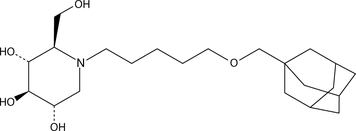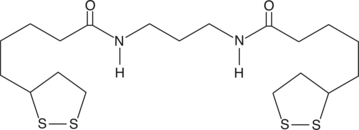Chemicals
Showing 9301–9450 of 41137 results
-
Amorolfine is an antifungal.{41490} It is active against isolates of T. rubrum, T. mentagrophytes, and C. albicans (MIC90s = 4-15, 4-60, and ≤30-500 ng/ml, respectively). It inhibits the growth of T. mentagrophytes and T. rubrum by 33.7 and 38.5%, respectively, in an in vitro bovine hoof model of onychomycosis.{36951} Amorolfine also decreases the fungal burden in a rabbit model of onychomycosis when used as a 5% nail lacquer.{36952} Formulations containing amorolfine have been used in the treatment of fungal infections of the toe- or fingernails.
Brand:CaymanSKU:26077 - 500 mgAvailable on backorder
Amoxapine is a tetracyclic antidepressant with a wide range of pharmacological effects. It inhibits norepinephrine and serotonin reuptake, binding the respective transporters with Kd values of 16 and 58 nM.{22877} It has also been shown to act as either an antagonist or inverse agonist at serotonin 5-HT2A, 2B, 2C, 3, 6, 7 (Kis = 1 and 2 nM for 5-HT2A and 5-HT2C, respectively), dopamine D2, 3, 4 (Kd = 160 nM for D2), α1-adrenergic (Kd = 50 nM), and histamine H1 (Kd = 25 nM) receptors.{25805,25914}
Brand:CaymanSKU:-Available on backorder
Amoxapine is a tetracyclic antidepressant with a wide range of pharmacological effects. It inhibits norepinephrine and serotonin reuptake, binding the respective transporters with Kd values of 16 and 58 nM.{22877} It has also been shown to act as either an antagonist or inverse agonist at serotonin 5-HT2A, 2B, 2C, 3, 6, 7 (Kis = 1 and 2 nM for 5-HT2A and 5-HT2C, respectively), dopamine D2, 3, 4 (Kd = 160 nM for D2), α1-adrenergic (Kd = 50 nM), and histamine H1 (Kd = 25 nM) receptors.{25805,25914}
Brand:CaymanSKU:-Available on backorder
Amoxapine is a tetracyclic antidepressant with a wide range of pharmacological effects. It inhibits norepinephrine and serotonin reuptake, binding the respective transporters with Kd values of 16 and 58 nM.{22877} It has also been shown to act as either an antagonist or inverse agonist at serotonin 5-HT2A, 2B, 2C, 3, 6, 7 (Kis = 1 and 2 nM for 5-HT2A and 5-HT2C, respectively), dopamine D2, 3, 4 (Kd = 160 nM for D2), α1-adrenergic (Kd = 50 nM), and histamine H1 (Kd = 25 nM) receptors.{25805,25914}
Brand:CaymanSKU:-Available on backorder
Amoxapine is a tetracyclic antidepressant with a wide range of pharmacological effects. It inhibits norepinephrine and serotonin reuptake, binding the respective transporters with Kd values of 16 and 58 nM.{22877} It has also been shown to act as either an antagonist or inverse agonist at serotonin 5-HT2A, 2B, 2C, 3, 6, 7 (Kis = 1 and 2 nM for 5-HT2A and 5-HT2C, respectively), dopamine D2, 3, 4 (Kd = 160 nM for D2), α1-adrenergic (Kd = 50 nM), and histamine H1 (Kd = 25 nM) receptors.{25805,25914}
Brand:CaymanSKU:-Available on backorder
Amoxicillin is an orally bioavailable, semisynthetic β-lactam antibiotic.{42429} It inhibits the growth of 30 isolates of P. mirabilis and 89% of 30 E. coli strains when used at concentrations greater than or equal to 5 and 10 µg/ml, respectively, but resistance develops in strains of Klebsiella, Enterobacter, and indole-positive Proteus species.{31108} Amoxicillin is susceptible to bacterial β-lactamases but is active against β-lactamase-producing bacteria when used in combination with β-lactamase antibiotics such as clavulanic acid with MIC values of greater than 4,096 and 16 µg/ml without or with clavulanic acid, respectively, against 46 clinical isolates of β-lactamase-producing E. coli.{42429} Formulations containing amoxicillin have been used in the treatment of a variety of bacterial infections.
Brand:CaymanSKU:-Available on backorder
Amoxicillin is an orally bioavailable, semisynthetic β-lactam antibiotic.{42429} It inhibits the growth of 30 isolates of P. mirabilis and 89% of 30 E. coli strains when used at concentrations greater than or equal to 5 and 10 µg/ml, respectively, but resistance develops in strains of Klebsiella, Enterobacter, and indole-positive Proteus species.{31108} Amoxicillin is susceptible to bacterial β-lactamases but is active against β-lactamase-producing bacteria when used in combination with β-lactamase antibiotics such as clavulanic acid with MIC values of greater than 4,096 and 16 µg/ml without or with clavulanic acid, respectively, against 46 clinical isolates of β-lactamase-producing E. coli.{42429} Formulations containing amoxicillin have been used in the treatment of a variety of bacterial infections.
Brand:CaymanSKU:-Available on backorder
Amoxicillin is an orally bioavailable, semisynthetic β-lactam antibiotic.{42429} It inhibits the growth of 30 isolates of P. mirabilis and 89% of 30 E. coli strains when used at concentrations greater than or equal to 5 and 10 µg/ml, respectively, but resistance develops in strains of Klebsiella, Enterobacter, and indole-positive Proteus species.{31108} Amoxicillin is susceptible to bacterial β-lactamases but is active against β-lactamase-producing bacteria when used in combination with β-lactamase antibiotics such as clavulanic acid with MIC values of greater than 4,096 and 16 µg/ml without or with clavulanic acid, respectively, against 46 clinical isolates of β-lactamase-producing E. coli.{42429} Formulations containing amoxicillin have been used in the treatment of a variety of bacterial infections.
Brand:CaymanSKU:-Available on backorder
Amoxicillin is an orally bioavailable, semisynthetic β-lactam antibiotic.{42429} It inhibits the growth of 30 isolates of P. mirabilis and 89% of 30 E. coli strains when used at concentrations greater than or equal to 5 and 10 µg/ml, respectively, but resistance develops in strains of Klebsiella, Enterobacter, and indole-positive Proteus species.{31108} Amoxicillin is susceptible to bacterial β-lactamases but is active against β-lactamase-producing bacteria when used in combination with β-lactamase antibiotics such as clavulanic acid with MIC values of greater than 4,096 and 16 µg/ml without or with clavulanic acid, respectively, against 46 clinical isolates of β-lactamase-producing E. coli.{42429} Formulations containing amoxicillin have been used in the treatment of a variety of bacterial infections.
Brand:CaymanSKU:-Available on backorder
The lipid messenger ceramide is converted to glucosylceramide by glucosylceramide synthase (GCS). In the reverse direction, non-lysosomal glucosylceramidase (GCase), also known as β-glucosidase 2 (BGD),{16474} cleaves the glucosyl moiety from glucosylceramide, liberating ceramide, which can be converted into sphingomyelin.{16472} AMP-deoxynojirimycin (AMP-dNM) is a hydrophobic derivative of dNM. It potently inhibits BGD (IC50 = 0.3 nM),{14948} less potently antagonizes GCS (IC50 = 25 nM),{16472} but only poorly inhibits other GCase isoforms. AMP-dNM has been shown to strongly suppress inflammation in a murine model of hapten-induced colitis,{16473} enhance insulin sensitivity in murine and rat models of insulin resistance,{14949} and induce sterol regulatory element-binding protein-regulated gene expression and cholesterol synthesis in HepG2 cells.{16474}
Brand:CaymanSKU:10010332 - 1 mgAvailable on backorder
The lipid messenger ceramide is converted to glucosylceramide by glucosylceramide synthase (GCS). In the reverse direction, non-lysosomal glucosylceramidase (GCase), also known as β-glucosidase 2 (BGD),{16474} cleaves the glucosyl moiety from glucosylceramide, liberating ceramide, which can be converted into sphingomyelin.{16472} AMP-deoxynojirimycin (AMP-dNM) is a hydrophobic derivative of dNM. It potently inhibits BGD (IC50 = 0.3 nM),{14948} less potently antagonizes GCS (IC50 = 25 nM),{16472} but only poorly inhibits other GCase isoforms. AMP-dNM has been shown to strongly suppress inflammation in a murine model of hapten-induced colitis,{16473} enhance insulin sensitivity in murine and rat models of insulin resistance,{14949} and induce sterol regulatory element-binding protein-regulated gene expression and cholesterol synthesis in HepG2 cells.{16474}
Brand:CaymanSKU:10010332 - 10 mgAvailable on backorder
The lipid messenger ceramide is converted to glucosylceramide by glucosylceramide synthase (GCS). In the reverse direction, non-lysosomal glucosylceramidase (GCase), also known as β-glucosidase 2 (BGD),{16474} cleaves the glucosyl moiety from glucosylceramide, liberating ceramide, which can be converted into sphingomyelin.{16472} AMP-deoxynojirimycin (AMP-dNM) is a hydrophobic derivative of dNM. It potently inhibits BGD (IC50 = 0.3 nM),{14948} less potently antagonizes GCS (IC50 = 25 nM),{16472} but only poorly inhibits other GCase isoforms. AMP-dNM has been shown to strongly suppress inflammation in a murine model of hapten-induced colitis,{16473} enhance insulin sensitivity in murine and rat models of insulin resistance,{14949} and induce sterol regulatory element-binding protein-regulated gene expression and cholesterol synthesis in HepG2 cells.{16474}
Brand:CaymanSKU:10010332 - 5 mgAvailable on backorder
The lipid messenger ceramide is converted to glucosylceramide by glucosylceramide synthase (GCS). In the reverse direction, non-lysosomal glucosylceramidase (GCase), also known as β-glucosidase 2 (BGD),{16474} cleaves the glucosyl moiety from glucosylceramide, liberating ceramide, which can be converted into sphingomyelin.{16472} AMP-deoxynojirimycin (AMP-dNM) is a hydrophobic derivative of dNM. It potently inhibits BGD (IC50 = 0.3 nM),{14948} less potently antagonizes GCS (IC50 = 25 nM),{16472} but only poorly inhibits other GCase isoforms. AMP-dNM has been shown to strongly suppress inflammation in a murine model of hapten-induced colitis,{16473} enhance insulin sensitivity in murine and rat models of insulin resistance,{14949} and induce sterol regulatory element-binding protein-regulated gene expression and cholesterol synthesis in HepG2 cells.{16474}
Brand:CaymanSKU:10010332 - 500 µgAvailable on backorder
Amphetamine methyl carbamate (Item No. 9002843) is an analytical reference standard that is structurally classified as an amphetamine. It is a precursor to amphetamine (Item Nos. ISO60188 | 14204) and methamphetamine (Item Nos. ISO60168 | 13998) via reduction of the functional carbamate group. This product is intended for research and forensic applications.
Brand:CaymanSKU:9002843 - 1 mgAvailable on backorder
Amphetamine methyl carbamate (Item No. 9002843) is an analytical reference standard that is structurally classified as an amphetamine. It is a precursor to amphetamine (Item Nos. ISO60188 | 14204) and methamphetamine (Item Nos. ISO60168 | 13998) via reduction of the functional carbamate group. This product is intended for research and forensic applications.
Brand:CaymanSKU:9002843 - 5 mgAvailable on backorder
Amphomycin is a natural antibacterial lipopeptide first isolated from S. canus. Lipopeptides are cyclic depsipeptides with a peptidyl side chain capped with a saturated alkyl tail.{27765} They preferentially target Gram-positive bacteria and may be useful against drug resistant strains.{27765} Amphomycin is also an inhibitor of peptidoglycan synthesis in both bacterial and mammalian systems, as it binds with phosphorylated substrates in a calcium-dependent manner.{27780,27781,27782,27779}
Brand:CaymanSKU:-Out of stock
Amphomycin is a natural antibacterial lipopeptide first isolated from S. canus. Lipopeptides are cyclic depsipeptides with a peptidyl side chain capped with a saturated alkyl tail.{27765} They preferentially target Gram-positive bacteria and may be useful against drug resistant strains.{27765} Amphomycin is also an inhibitor of peptidoglycan synthesis in both bacterial and mammalian systems, as it binds with phosphorylated substrates in a calcium-dependent manner.{27780,27781,27782,27779}
Brand:CaymanSKU:-Out of stock
Amphotericin B is a classic antifungal polyene macrolide that has been used in the treatment of systemic fungal infections, primarily caused by C. albicans, A. fumigatus, and parasitic L. protozoans, as well as in tissue culture to prevent fungi from contaminating cell cultures.{20815,20812,20813} Amphotericin B binds with ergosterol, the main component of fungal cell membranes, forming a transmembrane channel that results in altered plasma membrane permeability and leakage of vital cytoplasmic components, such as K+, ultimately inducing cell death.{20814} Because prolonged use of amphotericin B is associated with infusion-related events and nephrotoxicity, lipid-based formulations have been devised for more favorable clinical relevance.{20815,20812}
Brand:CaymanSKU:11636 - 1 gAvailable on backorder
Amphotericin B is a classic antifungal polyene macrolide that has been used in the treatment of systemic fungal infections, primarily caused by C. albicans, A. fumigatus, and parasitic L. protozoans, as well as in tissue culture to prevent fungi from contaminating cell cultures.{20815,20812,20813} Amphotericin B binds with ergosterol, the main component of fungal cell membranes, forming a transmembrane channel that results in altered plasma membrane permeability and leakage of vital cytoplasmic components, such as K+, ultimately inducing cell death.{20814} Because prolonged use of amphotericin B is associated with infusion-related events and nephrotoxicity, lipid-based formulations have been devised for more favorable clinical relevance.{20815,20812}
Brand:CaymanSKU:11636 - 5 gAvailable on backorder
Amphotericin B is a classic antifungal polyene macrolide that has been used in the treatment of systemic fungal infections, primarily caused by C. albicans, A. fumigatus, and parasitic L. protozoans, as well as in tissue culture to prevent fungi from contaminating cell cultures.{20815,20812,20813} Amphotericin B binds with ergosterol, the main component of fungal cell membranes, forming a transmembrane channel that results in altered plasma membrane permeability and leakage of vital cytoplasmic components, such as K+, ultimately inducing cell death.{20814} Because prolonged use of amphotericin B is associated with infusion-related events and nephrotoxicity, lipid-based formulations have been devised for more favorable clinical relevance.{20815,20812}
Brand:CaymanSKU:11636 - 500 mgAvailable on backorder
Ampicillin is a broad-spectrum antibiotic with activity against Gram-positive and Gram-negative bacteria, including veterinary isolates of S. pseudintermedius, S. aureus, E. coli, Pasteurella, and S. canis (MIC50s = 0.25, 0.5, 2, 0.12, and 0.25 μg/ml, respectively).{39898} In vivo, ampicillin (80 mg/kg, i.v.) reduces cough frequency, tachypnea, dyspnea, and fever and increases survival in a baboon (P. cynocephalus) model of pneumococcal pneumonia.{39899} Formulations containing ampicillin have been used to treat a variety of bacterial infections.
Brand:CaymanSKU:-Ampicillin is a broad-spectrum antibiotic with activity against Gram-positive and Gram-negative bacteria, including veterinary isolates of S. pseudintermedius, S. aureus, E. coli, Pasteurella, and S. canis (MIC50s = 0.25, 0.5, 2, 0.12, and 0.25 μg/ml, respectively).{39898} In vivo, ampicillin (80 mg/kg, i.v.) reduces cough frequency, tachypnea, dyspnea, and fever and increases survival in a baboon (P. cynocephalus) model of pneumococcal pneumonia.{39899} Formulations containing ampicillin have been used to treat a variety of bacterial infections.
Brand:CaymanSKU:-Ampicillin is a broad-spectrum antibiotic with activity against Gram-positive and Gram-negative bacteria, including veterinary isolates of S. pseudintermedius, S. aureus, E. coli, Pasteurella, and S. canis (MIC50s = 0.25, 0.5, 2, 0.12, and 0.25 μg/ml, respectively).{39898} In vivo, ampicillin (80 mg/kg, i.v.) reduces cough frequency, tachypnea, dyspnea, and fever and increases survival in a baboon (P. cynocephalus) model of pneumococcal pneumonia.{39899} Formulations containing ampicillin have been used to treat a variety of bacterial infections.
Brand:CaymanSKU:-Ampicillin is a broad-spectrum antibiotic with activity against Gram-positive and Gram-negative bacteria, including veterinary isolates of S. pseudintermedius, S. aureus, E. coli, Pasteurella, and S. canis (MIC50s = 0.25, 0.5, 2, 0.12, and 0.25 μg/ml, respectively).{39898} In vivo, ampicillin (80 mg/kg, i.v.) reduces cough frequency, tachypnea, dyspnea, and fever and increases survival in a baboon (P. cynocephalus) model of pneumococcal pneumonia.{39899} Formulations containing ampicillin have been used to treat a variety of bacterial infections.
Brand:CaymanSKU:-Ampiroxicam is a prodrug of piroxicam (Item No. 13368), a non-steroidal anti-inflammatory drug (NSAID) that non-selectively and reversibly inhibits COX-1 and COX-2 (IC50s = 1.57 and 1.69 μM, respectively).{38295,17755} Ampiroxicam is converted to piroxicam at a rate of 100, 90, 70, and 50% in humans, rats, dogs, and monkeys, respectively.{38295}
Brand:CaymanSKU:23026 - 1 gAvailable on backorder
Ampiroxicam is a prodrug of piroxicam (Item No. 13368), a non-steroidal anti-inflammatory drug (NSAID) that non-selectively and reversibly inhibits COX-1 and COX-2 (IC50s = 1.57 and 1.69 μM, respectively).{38295,17755} Ampiroxicam is converted to piroxicam at a rate of 100, 90, 70, and 50% in humans, rats, dogs, and monkeys, respectively.{38295}
Brand:CaymanSKU:23026 - 10 gAvailable on backorder
Ampiroxicam is a prodrug of piroxicam (Item No. 13368), a non-steroidal anti-inflammatory drug (NSAID) that non-selectively and reversibly inhibits COX-1 and COX-2 (IC50s = 1.57 and 1.69 μM, respectively).{38295,17755} Ampiroxicam is converted to piroxicam at a rate of 100, 90, 70, and 50% in humans, rats, dogs, and monkeys, respectively.{38295}
Brand:CaymanSKU:23026 - 5 gAvailable on backorder
Ampiroxicam is a prodrug of piroxicam (Item No. 13368), a non-steroidal anti-inflammatory drug (NSAID) that non-selectively and reversibly inhibits COX-1 and COX-2 (IC50s = 1.57 and 1.69 μM, respectively).{38295,17755} Ampiroxicam is converted to piroxicam at a rate of 100, 90, 70, and 50% in humans, rats, dogs, and monkeys, respectively.{38295}
Brand:CaymanSKU:23026 - 500 mgAvailable on backorder
AMPK activator is an indirect activator of AMP-activated protein kinase, AMPK (EC50 = 11.7 μM).{23464} It is thought to activate AMPK by inhibiting mitochondrial complex I, producing an increase in AMP levels.{23464} AMPK activator stimulates glucose uptake in L6 myocytes and promotes phosphorylation of acetyl-CoA carboxylase, a known target of AMPK.{23464} AMPK activator also decreases blood glucose concentrations in female Zucker diabetic rats, demonstrating its utility in whole animals.{23464} At 50 μM, it inhibits the growth of multiple myeloma cells.{23463} AMPK activator induces phosphorylation of raptor in PC3 prostate cancer cells, down-regulating mTORC1 signaling and reducing survivin expression.{23465}
Brand:CaymanSKU:-AMPK activator is an indirect activator of AMP-activated protein kinase, AMPK (EC50 = 11.7 μM).{23464} It is thought to activate AMPK by inhibiting mitochondrial complex I, producing an increase in AMP levels.{23464} AMPK activator stimulates glucose uptake in L6 myocytes and promotes phosphorylation of acetyl-CoA carboxylase, a known target of AMPK.{23464} AMPK activator also decreases blood glucose concentrations in female Zucker diabetic rats, demonstrating its utility in whole animals.{23464} At 50 μM, it inhibits the growth of multiple myeloma cells.{23463} AMPK activator induces phosphorylation of raptor in PC3 prostate cancer cells, down-regulating mTORC1 signaling and reducing survivin expression.{23465}
Brand:CaymanSKU:-AMPK activator is an indirect activator of AMP-activated protein kinase, AMPK (EC50 = 11.7 μM).{23464} It is thought to activate AMPK by inhibiting mitochondrial complex I, producing an increase in AMP levels.{23464} AMPK activator stimulates glucose uptake in L6 myocytes and promotes phosphorylation of acetyl-CoA carboxylase, a known target of AMPK.{23464} AMPK activator also decreases blood glucose concentrations in female Zucker diabetic rats, demonstrating its utility in whole animals.{23464} At 50 μM, it inhibits the growth of multiple myeloma cells.{23463} AMPK activator induces phosphorylation of raptor in PC3 prostate cancer cells, down-regulating mTORC1 signaling and reducing survivin expression.{23465}
Brand:CaymanSKU:-AMP-activated protein kinase (AMPK) plays a role in energy metabolism and glucose homeostasis by monitoring the ratio of ATP to AMP. AMPK stimulates glucose uptake in skeletal muscle when activated during muscle contraction and exercise by the phosphorylation of threonine 172 (Thr172) by LKB19 and Ca2+/calmodulin-dependent kinase kinase. Ampkinone is a small molecule activator of AMPK. It has been shown to stimulate functional activation of AMPK via the phosphorylation at Thr172 in cultured L6 muscle cells with an EC50 value of 4.3 μM, enhancing glucose uptake by 3.2-fold.{18631} When given to diet-induced obese mice,10 mg/kg ampkinone up-regulated the activity of AMPK in liver and muscle, enhancing insulin sensitivity and increasing the oxidation of adipose tissues.{18631}
Brand:CaymanSKU:10631 - 1 mgAvailable on backorder
AMP-activated protein kinase (AMPK) plays a role in energy metabolism and glucose homeostasis by monitoring the ratio of ATP to AMP. AMPK stimulates glucose uptake in skeletal muscle when activated during muscle contraction and exercise by the phosphorylation of threonine 172 (Thr172) by LKB19 and Ca2+/calmodulin-dependent kinase kinase. Ampkinone is a small molecule activator of AMPK. It has been shown to stimulate functional activation of AMPK via the phosphorylation at Thr172 in cultured L6 muscle cells with an EC50 value of 4.3 μM, enhancing glucose uptake by 3.2-fold.{18631} When given to diet-induced obese mice,10 mg/kg ampkinone up-regulated the activity of AMPK in liver and muscle, enhancing insulin sensitivity and increasing the oxidation of adipose tissues.{18631}
Brand:CaymanSKU:10631 - 10 mgAvailable on backorder
AMP-activated protein kinase (AMPK) plays a role in energy metabolism and glucose homeostasis by monitoring the ratio of ATP to AMP. AMPK stimulates glucose uptake in skeletal muscle when activated during muscle contraction and exercise by the phosphorylation of threonine 172 (Thr172) by LKB19 and Ca2+/calmodulin-dependent kinase kinase. Ampkinone is a small molecule activator of AMPK. It has been shown to stimulate functional activation of AMPK via the phosphorylation at Thr172 in cultured L6 muscle cells with an EC50 value of 4.3 μM, enhancing glucose uptake by 3.2-fold.{18631} When given to diet-induced obese mice,10 mg/kg ampkinone up-regulated the activity of AMPK in liver and muscle, enhancing insulin sensitivity and increasing the oxidation of adipose tissues.{18631}
Brand:CaymanSKU:10631 - 5 mgAvailable on backorder
Amprenavir is an inhibitor of HIV protease (Ki = 0.04 nM).{25257} It inhibits the cytopathic effects of HIV-1 in MT-4 cells (IC50 = 150 nM). Formulations containing amprenavir have been used in combination with other antiretroviral agents in the treatment of HIV-1 infection.
Brand:CaymanSKU:-Amprenavir is an inhibitor of HIV protease (Ki = 0.04 nM).{25257} It inhibits the cytopathic effects of HIV-1 in MT-4 cells (IC50 = 150 nM). Formulations containing amprenavir have been used in combination with other antiretroviral agents in the treatment of HIV-1 infection.
Brand:CaymanSKU:-Amprenavir is an inhibitor of HIV protease (Ki = 0.04 nM).{25257} It inhibits the cytopathic effects of HIV-1 in MT-4 cells (IC50 = 150 nM). Formulations containing amprenavir have been used in combination with other antiretroviral agents in the treatment of HIV-1 infection.
Brand:CaymanSKU:-Amprenavir is an inhibitor of HIV protease (Ki = 0.04 nM).{25257} It inhibits the cytopathic effects of HIV-1 in MT-4 cells (IC50 = 150 nM). Formulations containing amprenavir have been used in combination with other antiretroviral agents in the treatment of HIV-1 infection.
Brand:CaymanSKU:-Amprolium is a thiamine analog and antiprotozoal agent that interferes with thiamine metabolism and inhibits carbohydrate synthesis.{39908,39909,39910,39911} It competitively inhibits thiamine uptake by E. tenella schizonts and by chick host intestinal cells (Kis = 7.6 and 326 μM, respectively).{39908} It also inhibits hexose formation and pentose utilization ex vivo in isolated lysed rat erythrocytes and in liver, kidney, heart, and intestinal tissue homogenates following dietary administration.{39909} Amprolium (1,000 ppm in feed) inhibits oocyst output and sporulation of Eimeria maxima, E. brunetti, and E. acervulina in infected chicks.{39910} It also decreases lesion and oocyst scores and mortality of E. tenella-infected chicks following dietary administration of a 125 ppm dose.{39911} Amprolium (100 μM) induces apoptosis in PC12 rat adrenal cells and increases the level of cleaved caspase-3.{39912} Formulations containing amprolium have been used as coccidiostats in poultry processing.
Brand:CaymanSKU:25506 - 100 gAvailable on backorder
Amprolium is a thiamine analog and antiprotozoal agent that interferes with thiamine metabolism and inhibits carbohydrate synthesis.{39908,39909,39910,39911} It competitively inhibits thiamine uptake by E. tenella schizonts and by chick host intestinal cells (Kis = 7.6 and 326 μM, respectively).{39908} It also inhibits hexose formation and pentose utilization ex vivo in isolated lysed rat erythrocytes and in liver, kidney, heart, and intestinal tissue homogenates following dietary administration.{39909} Amprolium (1,000 ppm in feed) inhibits oocyst output and sporulation of Eimeria maxima, E. brunetti, and E. acervulina in infected chicks.{39910} It also decreases lesion and oocyst scores and mortality of E. tenella-infected chicks following dietary administration of a 125 ppm dose.{39911} Amprolium (100 μM) induces apoptosis in PC12 rat adrenal cells and increases the level of cleaved caspase-3.{39912} Formulations containing amprolium have been used as coccidiostats in poultry processing.
Brand:CaymanSKU:25506 - 25 gAvailable on backorder
Amprolium is a thiamine analog and antiprotozoal agent that interferes with thiamine metabolism and inhibits carbohydrate synthesis.{39908,39909,39910,39911} It competitively inhibits thiamine uptake by E. tenella schizonts and by chick host intestinal cells (Kis = 7.6 and 326 μM, respectively).{39908} It also inhibits hexose formation and pentose utilization ex vivo in isolated lysed rat erythrocytes and in liver, kidney, heart, and intestinal tissue homogenates following dietary administration.{39909} Amprolium (1,000 ppm in feed) inhibits oocyst output and sporulation of Eimeria maxima, E. brunetti, and E. acervulina in infected chicks.{39910} It also decreases lesion and oocyst scores and mortality of E. tenella-infected chicks following dietary administration of a 125 ppm dose.{39911} Amprolium (100 μM) induces apoptosis in PC12 rat adrenal cells and increases the level of cleaved caspase-3.{39912} Formulations containing amprolium have been used as coccidiostats in poultry processing.
Brand:CaymanSKU:25506 - 250 gAvailable on backorder
Amprolium is a thiamine analog and antiprotozoal agent that interferes with thiamine metabolism and inhibits carbohydrate synthesis.{39908,39909,39910,39911} It competitively inhibits thiamine uptake by E. tenella schizonts and by chick host intestinal cells (Kis = 7.6 and 326 μM, respectively).{39908} It also inhibits hexose formation and pentose utilization ex vivo in isolated lysed rat erythrocytes and in liver, kidney, heart, and intestinal tissue homogenates following dietary administration.{39909} Amprolium (1,000 ppm in feed) inhibits oocyst output and sporulation of Eimeria maxima, E. brunetti, and E. acervulina in infected chicks.{39910} It also decreases lesion and oocyst scores and mortality of E. tenella-infected chicks following dietary administration of a 125 ppm dose.{39911} Amprolium (100 μM) induces apoptosis in PC12 rat adrenal cells and increases the level of cleaved caspase-3.{39912} Formulations containing amprolium have been used as coccidiostats in poultry processing.
Brand:CaymanSKU:25506 - 50 gAvailable on backorder
Amrinone is an inhibitor of phosphodiesterase 3 (PDE3; IC50 = 19.5 µM).{36379} It increases developed tension and contractile force in isolated cat papillary muscle.{36378} Amrinone (1-10 mg/kg) has positive inotropic effects, increasing the rate and force of heart contraction in anesthetized and unanesthetized dogs.
Brand:CaymanSKU:23898 - 1 gAvailable on backorder
Amrinone is an inhibitor of phosphodiesterase 3 (PDE3; IC50 = 19.5 µM).{36379} It increases developed tension and contractile force in isolated cat papillary muscle.{36378} Amrinone (1-10 mg/kg) has positive inotropic effects, increasing the rate and force of heart contraction in anesthetized and unanesthetized dogs.
Brand:CaymanSKU:23898 - 250 mgAvailable on backorder
Amrinone is an inhibitor of phosphodiesterase 3 (PDE3; IC50 = 19.5 µM).{36379} It increases developed tension and contractile force in isolated cat papillary muscle.{36378} Amrinone (1-10 mg/kg) has positive inotropic effects, increasing the rate and force of heart contraction in anesthetized and unanesthetized dogs.
Brand:CaymanSKU:23898 - 5 gAvailable on backorder
Amrinone is an inhibitor of phosphodiesterase 3 (PDE3; IC50 = 19.5 µM).{36379} It increases developed tension and contractile force in isolated cat papillary muscle.{36378} Amrinone (1-10 mg/kg) has positive inotropic effects, increasing the rate and force of heart contraction in anesthetized and unanesthetized dogs.
Brand:CaymanSKU:23898 - 500 mgAvailable on backorder
Amsacrine is a topoisomerase II poison.{41155} It stimulates formation of a complex between DNA and topoisomerase II in which the DNA is cleaved and topoisomerase II remains covalently linked to the 5’ end of the DNA cleavage products. Amsacrine also inhibits the DNA strand-passing activity of topoisomerase II at a concentration of 20 μg/ml. It reduces growth of LoVo human colorectal carcinoma and T1 human lymphoma cells in a dose-dependent manner and this effect is 10-fold more potent in proliferating cells compared to non-proliferating cells.{41156} Amsacrine has antitumor activity against several murine leukemia, melanoma, lung, colon, and mammary xenograft mouse models.{41157}
Brand:CaymanSKU:22223 -Out of stock
Amsacrine is a topoisomerase II poison.{41155} It stimulates formation of a complex between DNA and topoisomerase II in which the DNA is cleaved and topoisomerase II remains covalently linked to the 5’ end of the DNA cleavage products. Amsacrine also inhibits the DNA strand-passing activity of topoisomerase II at a concentration of 20 μg/ml. It reduces growth of LoVo human colorectal carcinoma and T1 human lymphoma cells in a dose-dependent manner and this effect is 10-fold more potent in proliferating cells compared to non-proliferating cells.{41156} Amsacrine has antitumor activity against several murine leukemia, melanoma, lung, colon, and mammary xenograft mouse models.{41157}
Brand:CaymanSKU:22223 -Out of stock
Amsacrine is a topoisomerase II poison.{41155} It stimulates formation of a complex between DNA and topoisomerase II in which the DNA is cleaved and topoisomerase II remains covalently linked to the 5’ end of the DNA cleavage products. Amsacrine also inhibits the DNA strand-passing activity of topoisomerase II at a concentration of 20 μg/ml. It reduces growth of LoVo human colorectal carcinoma and T1 human lymphoma cells in a dose-dependent manner and this effect is 10-fold more potent in proliferating cells compared to non-proliferating cells.{41156} Amsacrine has antitumor activity against several murine leukemia, melanoma, lung, colon, and mammary xenograft mouse models.{41157}
Brand:CaymanSKU:22223 -Out of stock
Amsacrine is a topoisomerase II poison.{41155} It stimulates formation of a complex between DNA and topoisomerase II in which the DNA is cleaved and topoisomerase II remains covalently linked to the 5’ end of the DNA cleavage products. Amsacrine also inhibits the DNA strand-passing activity of topoisomerase II at a concentration of 20 μg/ml. It reduces growth of LoVo human colorectal carcinoma and T1 human lymphoma cells in a dose-dependent manner and this effect is 10-fold more potent in proliferating cells compared to non-proliferating cells.{41156} Amsacrine has antitumor activity against several murine leukemia, melanoma, lung, colon, and mammary xenograft mouse models.{41157}
Brand:CaymanSKU:22223 -Out of stock
AMT is a potent, relatively selective inhibitor of iNOS with a Ki of 4.2 nM in mouse macrophages. It inhibits other isoforms of NOS, but at higher concentrations; the IC50 values for rat nNOS and bovine eNOS are 34 and 150 nM, respectively.{1351}
Brand:CaymanSKU:81010 - 10 mgAvailable on backorder
AMT is a potent, relatively selective inhibitor of iNOS with a Ki of 4.2 nM in mouse macrophages. It inhibits other isoforms of NOS, but at higher concentrations; the IC50 values for rat nNOS and bovine eNOS are 34 and 150 nM, respectively.{1351}
Brand:CaymanSKU:81010 - 100 mgAvailable on backorder
AMT is a potent, relatively selective inhibitor of iNOS with a Ki of 4.2 nM in mouse macrophages. It inhibits other isoforms of NOS, but at higher concentrations; the IC50 values for rat nNOS and bovine eNOS are 34 and 150 nM, respectively.{1351}
Brand:CaymanSKU:81010 - 5 mgAvailable on backorder
AMT is a potent, relatively selective inhibitor of iNOS with a Ki of 4.2 nM in mouse macrophages. It inhibits other isoforms of NOS, but at higher concentrations; the IC50 values for rat nNOS and bovine eNOS are 34 and 150 nM, respectively.{1351}
Brand:CaymanSKU:81010 - 50 mgAvailable on backorder
AMTB is an antagonist of transient receptor potential melastatin 8 (TRPM8).{37683} It inhibits calcium influx induced by the TRPM8 agonist icilin (Item No. 10137) with an IC50 value of 0.58 µM. AMTB (3 mg/kg) decreases the number of volume-induced bladder contractions in a rat model of noxious bladder distension. It also decreases the visceromotor reflex response to urinary bladder distension (ID50 = 2.42 mg/kg), indicating antinociceptive activity. AMTB inhibits the sodium channel (Nav) isoforms Nav1.1-1.8 (IC50s = 2-14.8 µM) and decreases viability of MDA-MB-231 and SK-BR-3 breast cancer cells (IC50s = ~23.7 and 17.3 µM, respectively) in a TRPM8-independent manner.{37684}
Brand:CaymanSKU:25336 - 1 mgAvailable on backorder
AMTB is an antagonist of transient receptor potential melastatin 8 (TRPM8).{37683} It inhibits calcium influx induced by the TRPM8 agonist icilin (Item No. 10137) with an IC50 value of 0.58 µM. AMTB (3 mg/kg) decreases the number of volume-induced bladder contractions in a rat model of noxious bladder distension. It also decreases the visceromotor reflex response to urinary bladder distension (ID50 = 2.42 mg/kg), indicating antinociceptive activity. AMTB inhibits the sodium channel (Nav) isoforms Nav1.1-1.8 (IC50s = 2-14.8 µM) and decreases viability of MDA-MB-231 and SK-BR-3 breast cancer cells (IC50s = ~23.7 and 17.3 µM, respectively) in a TRPM8-independent manner.{37684}
Brand:CaymanSKU:25336 - 10 mgAvailable on backorder
AMTB is an antagonist of transient receptor potential melastatin 8 (TRPM8).{37683} It inhibits calcium influx induced by the TRPM8 agonist icilin (Item No. 10137) with an IC50 value of 0.58 µM. AMTB (3 mg/kg) decreases the number of volume-induced bladder contractions in a rat model of noxious bladder distension. It also decreases the visceromotor reflex response to urinary bladder distension (ID50 = 2.42 mg/kg), indicating antinociceptive activity. AMTB inhibits the sodium channel (Nav) isoforms Nav1.1-1.8 (IC50s = 2-14.8 µM) and decreases viability of MDA-MB-231 and SK-BR-3 breast cancer cells (IC50s = ~23.7 and 17.3 µM, respectively) in a TRPM8-independent manner.{37684}
Brand:CaymanSKU:25336 - 25 mgAvailable on backorder
AMTB is an antagonist of transient receptor potential melastatin 8 (TRPM8).{37683} It inhibits calcium influx induced by the TRPM8 agonist icilin (Item No. 10137) with an IC50 value of 0.58 µM. AMTB (3 mg/kg) decreases the number of volume-induced bladder contractions in a rat model of noxious bladder distension. It also decreases the visceromotor reflex response to urinary bladder distension (ID50 = 2.42 mg/kg), indicating antinociceptive activity. AMTB inhibits the sodium channel (Nav) isoforms Nav1.1-1.8 (IC50s = 2-14.8 µM) and decreases viability of MDA-MB-231 and SK-BR-3 breast cancer cells (IC50s = ~23.7 and 17.3 µM, respectively) in a TRPM8-independent manner.{37684}
Brand:CaymanSKU:25336 - 5 mgAvailable on backorder
Amthamine is a histamine H2 receptor agonist (pD2 = 6.21 in isolated guinea pig atria).{48758} It is selective for H2 over H3 receptors (pD2 = 4.7 in isolated guinea pig ileum). Amthamine increases heart rate in spontaneously beating isolated guinea pig atria (pD2 = 6.72) and decreases contractions induced by cholecystokinin (CCK) octapeptide in a dose-dependent manner in isolated guinea pig gallbladder strips.{48759,48760} It increases sheep red blood cell-induced production of IgG and IgM antibodies in rabbit serum when administered at a dose of 10 µg/kg twice per day.{47697}
Brand:CaymanSKU:29503 - 10 mgAvailable on backorder
Amthamine is a histamine H2 receptor agonist (pD2 = 6.21 in isolated guinea pig atria).{48758} It is selective for H2 over H3 receptors (pD2 = 4.7 in isolated guinea pig ileum). Amthamine increases heart rate in spontaneously beating isolated guinea pig atria (pD2 = 6.72) and decreases contractions induced by cholecystokinin (CCK) octapeptide in a dose-dependent manner in isolated guinea pig gallbladder strips.{48759,48760} It increases sheep red blood cell-induced production of IgG and IgM antibodies in rabbit serum when administered at a dose of 10 µg/kg twice per day.{47697}
Brand:CaymanSKU:29503 - 25 mgAvailable on backorder
Amthamine is a histamine H2 receptor agonist (pD2 = 6.21 in isolated guinea pig atria).{48758} It is selective for H2 over H3 receptors (pD2 = 4.7 in isolated guinea pig ileum). Amthamine increases heart rate in spontaneously beating isolated guinea pig atria (pD2 = 6.72) and decreases contractions induced by cholecystokinin (CCK) octapeptide in a dose-dependent manner in isolated guinea pig gallbladder strips.{48759,48760} It increases sheep red blood cell-induced production of IgG and IgM antibodies in rabbit serum when administered at a dose of 10 µg/kg twice per day.{47697}
Brand:CaymanSKU:29503 - 5 mgAvailable on backorder
Amuvatinib is a multi-targeted inhibitor of receptor tyrosine kinases that inhibits c-Kit, platelet-derived growth factor receptor α (PDGFRα), and c-Met (IC50s = 10, 40, and 81 nM, respectively).{34322} It inhibits growth and induces apoptosis in prostate cancer cell lines, with additive effects achieved when combined with erlotinib (Item No. 10483).{34322} Amuvatinib sensitizes cancer cells to radiation and chemotherapeutic compounds, in part by inhibiting homologous recombination.{29344,34323,34324}
Brand:CaymanSKU:21461 -Out of stock
Amuvatinib is a multi-targeted inhibitor of receptor tyrosine kinases that inhibits c-Kit, platelet-derived growth factor receptor α (PDGFRα), and c-Met (IC50s = 10, 40, and 81 nM, respectively).{34322} It inhibits growth and induces apoptosis in prostate cancer cell lines, with additive effects achieved when combined with erlotinib (Item No. 10483).{34322} Amuvatinib sensitizes cancer cells to radiation and chemotherapeutic compounds, in part by inhibiting homologous recombination.{29344,34323,34324}
Brand:CaymanSKU:21461 -Out of stock
Amuvatinib is a multi-targeted inhibitor of receptor tyrosine kinases that inhibits c-Kit, platelet-derived growth factor receptor α (PDGFRα), and c-Met (IC50s = 10, 40, and 81 nM, respectively).{34322} It inhibits growth and induces apoptosis in prostate cancer cell lines, with additive effects achieved when combined with erlotinib (Item No. 10483).{34322} Amuvatinib sensitizes cancer cells to radiation and chemotherapeutic compounds, in part by inhibiting homologous recombination.{29344,34323,34324}
Brand:CaymanSKU:21461 -Out of stock
Amuvatinib is a multi-targeted inhibitor of receptor tyrosine kinases that inhibits c-Kit, platelet-derived growth factor receptor α (PDGFRα), and c-Met (IC50s = 10, 40, and 81 nM, respectively).{34322} It inhibits growth and induces apoptosis in prostate cancer cell lines, with additive effects achieved when combined with erlotinib (Item No. 10483).{34322} Amuvatinib sensitizes cancer cells to radiation and chemotherapeutic compounds, in part by inhibiting homologous recombination.{29344,34323,34324}
Brand:CaymanSKU:21461 -Out of stock
Amygdalin is a cyanogenic glycoside that has been found in seeds from plants of the Rosaceae family and has diverse biological activities.{47285,47286,47287,47288,47289} It induces cell cycle arrest at the G0/G1 phase, decreases cyclin A and Cdk2 levels, and inhibits cell growth in UMUC-3, RT112, and TCCSUP bladder cancer cells when used at concentrations ranging from 1.25 to 10 mg/ml.{47286} Amygdalin (3 mg/kg) reduces the number of primary microtubules and microvessels in aortic rings isolated from rats with diabetes induced by streptozotocin (Item No. 13104).{47287} In vivo, amygdalin reduces triglyceride, total cholesterol, and LDL levels and aortic sinus plaque area in an LDLR-/- mouse model of atherosclerosis.{47288} It also reduces production of TNF-α, IL-1β, and IL-6, as well as neutrophil and macrophage infiltration, in bronchoalveolar lavage fluid (BALF) in a mouse model of LPS-induced acute lung injury.{47289}
Brand:CaymanSKU:26668 - 10 gAvailable on backorder
Amygdalin is a cyanogenic glycoside that has been found in seeds from plants of the Rosaceae family and has diverse biological activities.{47285,47286,47287,47288,47289} It induces cell cycle arrest at the G0/G1 phase, decreases cyclin A and Cdk2 levels, and inhibits cell growth in UMUC-3, RT112, and TCCSUP bladder cancer cells when used at concentrations ranging from 1.25 to 10 mg/ml.{47286} Amygdalin (3 mg/kg) reduces the number of primary microtubules and microvessels in aortic rings isolated from rats with diabetes induced by streptozotocin (Item No. 13104).{47287} In vivo, amygdalin reduces triglyceride, total cholesterol, and LDL levels and aortic sinus plaque area in an LDLR-/- mouse model of atherosclerosis.{47288} It also reduces production of TNF-α, IL-1β, and IL-6, as well as neutrophil and macrophage infiltration, in bronchoalveolar lavage fluid (BALF) in a mouse model of LPS-induced acute lung injury.{47289}
Brand:CaymanSKU:26668 - 25 gAvailable on backorder
Amygdalin is a cyanogenic glycoside that has been found in seeds from plants of the Rosaceae family and has diverse biological activities.{47285,47286,47287,47288,47289} It induces cell cycle arrest at the G0/G1 phase, decreases cyclin A and Cdk2 levels, and inhibits cell growth in UMUC-3, RT112, and TCCSUP bladder cancer cells when used at concentrations ranging from 1.25 to 10 mg/ml.{47286} Amygdalin (3 mg/kg) reduces the number of primary microtubules and microvessels in aortic rings isolated from rats with diabetes induced by streptozotocin (Item No. 13104).{47287} In vivo, amygdalin reduces triglyceride, total cholesterol, and LDL levels and aortic sinus plaque area in an LDLR-/- mouse model of atherosclerosis.{47288} It also reduces production of TNF-α, IL-1β, and IL-6, as well as neutrophil and macrophage infiltration, in bronchoalveolar lavage fluid (BALF) in a mouse model of LPS-induced acute lung injury.{47289}
Brand:CaymanSKU:26668 - 5 gAvailable on backorder
Amygdalin is a cyanogenic glycoside that has been found in seeds from plants of the Rosaceae family and has diverse biological activities.{47285,47286,47287,47288,47289} It induces cell cycle arrest at the G0/G1 phase, decreases cyclin A and Cdk2 levels, and inhibits cell growth in UMUC-3, RT112, and TCCSUP bladder cancer cells when used at concentrations ranging from 1.25 to 10 mg/ml.{47286} Amygdalin (3 mg/kg) reduces the number of primary microtubules and microvessels in aortic rings isolated from rats with diabetes induced by streptozotocin (Item No. 13104).{47287} In vivo, amygdalin reduces triglyceride, total cholesterol, and LDL levels and aortic sinus plaque area in an LDLR-/- mouse model of atherosclerosis.{47288} It also reduces production of TNF-α, IL-1β, and IL-6, as well as neutrophil and macrophage infiltration, in bronchoalveolar lavage fluid (BALF) in a mouse model of LPS-induced acute lung injury.{47289}
Brand:CaymanSKU:26668 - 50 gAvailable on backorder
Amylose is a polysaccharide made of α-D-glucose units, bound to each other through α(1→4) glycosidic bonds. It constitutes about 20% of starch, the major storage carbohydrate in plants. It can act as an indicator, turning blue in the presence of iodine, and has also been coupled to magnetic beads for the isolation and purification of maltose-binding protein fusion proteins.{28627,28628}
Brand:CaymanSKU:-Available on backorder
Amylose is a polysaccharide made of α-D-glucose units, bound to each other through α(1→4) glycosidic bonds. It constitutes about 20% of starch, the major storage carbohydrate in plants. It can act as an indicator, turning blue in the presence of iodine, and has also been coupled to magnetic beads for the isolation and purification of maltose-binding protein fusion proteins.{28627,28628}
Brand:CaymanSKU:-Available on backorder
Amylose is a polysaccharide made of α-D-glucose units, bound to each other through α(1→4) glycosidic bonds. It constitutes about 20% of starch, the major storage carbohydrate in plants. It can act as an indicator, turning blue in the presence of iodine, and has also been coupled to magnetic beads for the isolation and purification of maltose-binding protein fusion proteins.{28627,28628}
Brand:CaymanSKU:-Available on backorder
Amylose is a polysaccharide made of α-D-glucose units, bound to each other through α(1→4) glycosidic bonds. It constitutes about 20% of starch, the major storage carbohydrate in plants. It can act as an indicator, turning blue in the presence of iodine, and has also been coupled to magnetic beads for the isolation and purification of maltose-binding protein fusion proteins.{28627,28628}
Brand:CaymanSKU:-Available on backorder
AN-2690 is a broad spectrum antifungal agent with MIC values ranging from 0.25-1 μg/mL against T. rubrum, T. mentagrophytes, C. albicans, C. neoformans, and A. fumigatus.{41073} It inhibits tRNA aminoacylation (IC50 = 2.1 μM) and hydrolysis of Ile-tRNALeu in a dose-dependent manner in vitro.{41074} Formulations containing AN-2690 are under clinical investigation for the treatment of onychomycosis.
Brand:CaymanSKU:23101 - 1 gAvailable on backorder
AN-2690 is a broad spectrum antifungal agent with MIC values ranging from 0.25-1 μg/mL against T. rubrum, T. mentagrophytes, C. albicans, C. neoformans, and A. fumigatus.{41073} It inhibits tRNA aminoacylation (IC50 = 2.1 μM) and hydrolysis of Ile-tRNALeu in a dose-dependent manner in vitro.{41074} Formulations containing AN-2690 are under clinical investigation for the treatment of onychomycosis.
Brand:CaymanSKU:23101 - 5 gAvailable on backorder
α-Lipoic acid is a cyclic disulfide antioxidant that interconverts with its reduced dithiol form. It is an essential cofactor for decarboxylation reactions of the citric acid cycle and acts as a general antioxidant.{12280} AN-7 is a more lipophilic analog of α-lipoic acid with enhanced potency and 1.5-fold increased maximal capacity to stimulate glucose transport into myocytes.{12283} This identifies the analogs of lipoic acid as potential new treatments for diabetes.
Brand:CaymanSKU:10006212 - 1 mgAvailable on backorder
α-Lipoic acid is a cyclic disulfide antioxidant that interconverts with its reduced dithiol form. It is an essential cofactor for decarboxylation reactions of the citric acid cycle and acts as a general antioxidant.{12280} AN-7 is a more lipophilic analog of α-lipoic acid with enhanced potency and 1.5-fold increased maximal capacity to stimulate glucose transport into myocytes.{12283} This identifies the analogs of lipoic acid as potential new treatments for diabetes.
Brand:CaymanSKU:10006212 - 10 mgAvailable on backorder
α-Lipoic acid is a cyclic disulfide antioxidant that interconverts with its reduced dithiol form. It is an essential cofactor for decarboxylation reactions of the citric acid cycle and acts as a general antioxidant.{12280} AN-7 is a more lipophilic analog of α-lipoic acid with enhanced potency and 1.5-fold increased maximal capacity to stimulate glucose transport into myocytes.{12283} This identifies the analogs of lipoic acid as potential new treatments for diabetes.
Brand:CaymanSKU:10006212 - 5 mgAvailable on backorder
AN2718 is a benzoxaborole compound that displays broad antifungal effectiveness in vitro.{34048} It inhibits leucyl-tRNA synthetase (LeuRS) from molds and yeasts (IC50s = 2 and 4.2 µM for A. fumigatus and C. albicans LeuRS, respectively), blocking protein synthesis.{34048}
Brand:CaymanSKU:20708 -Available on backorder
AN2718 is a benzoxaborole compound that displays broad antifungal effectiveness in vitro.{34048} It inhibits leucyl-tRNA synthetase (LeuRS) from molds and yeasts (IC50s = 2 and 4.2 µM for A. fumigatus and C. albicans LeuRS, respectively), blocking protein synthesis.{34048}
Brand:CaymanSKU:20708 -Available on backorder
AN2718 is a benzoxaborole compound that displays broad antifungal effectiveness in vitro.{34048} It inhibits leucyl-tRNA synthetase (LeuRS) from molds and yeasts (IC50s = 2 and 4.2 µM for A. fumigatus and C. albicans LeuRS, respectively), blocking protein synthesis.{34048}
Brand:CaymanSKU:20708 -Available on backorder























